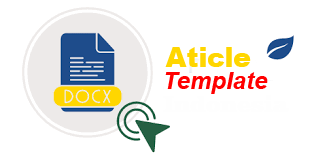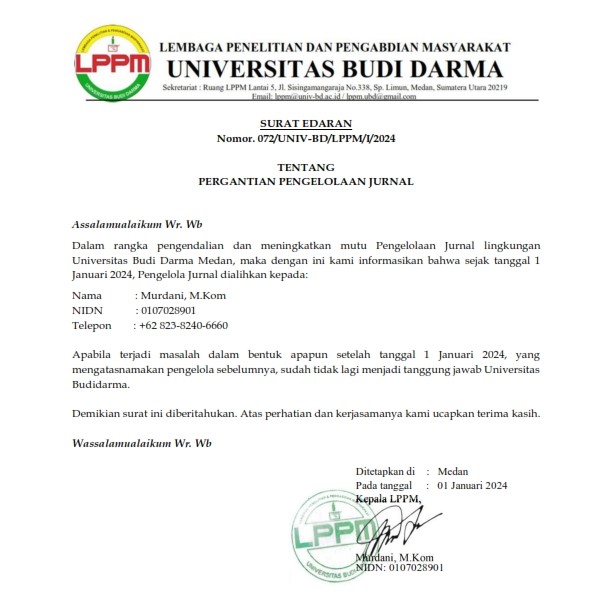Klasifikasi Kelayakan Pemberian Kredit Pada Calon Debitur Menggunakan Naïve Bayes
DOI:
https://doi.org/10.30865/jurikom.v9i6.5131Keywords:
Data Mining, Naïve Bayes, Classification, Accuracy, DebtursAbstract
As a lending company, PT. PRIMA KONSUMEN FINANCE certainly has the possibility of bad credit in extending credit to its debtors which can reduce the company's income. Therefore the author performs data mining analysis on debtor data that has borrowed at PT. PRIMA KONSUMEN FINANCE to become valuable information for the company. The author uses debtor data in 2019 as many as 265 data. In conducting the analysis the author uses the WEKA Tools tool. The method used is the Naïve Bayes classification method with 9 attributes. The contribution of this research is to build a creditworthiness classification model for prospective borrowers. This model produces classification performance evaluation values for 3 test options, namely the training set option, 5-fold cross validation and 10-fold cross validation. The contribution of this research is to produce a creditworthiness classification model The results of the Naïve Bayes classification with the greatest percentage of accuracy were obtained using the Training Set, which was 72.8302%, using 5-fold cross validation of 63.3962% and using 10-Fold Cross Validation of 66.4151%.
References
A. S. Osman, “Data mining techniques: Review,†Int. J. Data Sci. Res., vol. 2, no. 1, pp. 1–4, 2019.
J. Mughal, M. Jawad, and H. Mughal, “Data Mining: Web Data Mining Techniques, Tools and Algorithms: An Overview Cite this paper Related papers A Syst emat ic Review Web Cont ent Mining Tools and it s Applicat ions Manjunat h Pujar A Syst emat ic Review Web Cont ent Mining Tools and it s Appl,†IJACSA) Int. J. Adv. Comput. Sci. Appl., vol. 9, no. 6, 2018, [Online]. Available: www.ijacsa.thesai.org
J. Jasmir, S. Nurmaini, R. F. Malik, and D. Z. Abidin, “Text Classification of Cancer Clinical Trials Documents Using Deep Neural Network and Fine Grained Document Clustering,†vol. 172, no. Siconian 2019, 2020, doi: 10.2991/aisr.k.200424.061.
J. Jasmir, S. Nurmaini, R. F. Malik, and B. Tutuko, “Bigram feature extraction and conditional random fields model to improve text classification clinical trial document,†Telkomnika (Telecommunication Comput. Electron. Control., vol. 19, no. 3, pp. 886–892, 2021, doi: 10.12928/TELKOMNIKA.v19i3.18357.
J. Jasmir, S. Nurmaini, and B. Tutuko, “Fine-grained algorithm for improving knn computational performance on clinical trials text classification,†Big Data Cogn. Comput., vol. 5, no. 4, 2021, doi: 10.3390/bdcc5040060.
J. Jasmir, W. Riyadi, S. R. Agustini, Y. Arvita, D. Meisak, and L. Aryani, “Bidirectional Long Short-Term Memory and Word Embedding Feature for,†J. RESTI (Rekayasa Sist. Dan Teknol. Informasi), vol. 6, no. 4, pp. 505–510, 2022, [Online]. Available: https://jurnal.iaii.or.id/index.php/RESTI/article/view/4005/606
S. Nurmaini, R. U. Partan, W. Caesarendra, and T. Dewi, “An Automated ECG Beat Classification System Using Deep Neural Networks with an Unsupervised Feature Extraction Technique,†Appl. Sci., vol. 9, 2019.
A. H. Nasyuha, “Implementasi Teorema Bayes Untuk Diagnosa Penyakit Hawar Daun Bakteri ( Kresek ) Dan Penyakit Blas Tanaman Padi,†vol. 9, no. 4, pp. 777–783, 2022, doi: 10.30865/jurikom.v9i4.4350.
Y. N. Nanik Rahmawati, Jasmir Jasmir, “Klasifikasi Kondisi Gizi Balita Menggunakan Metode Naive Bayes (Studi Kasus Posyandu Melati IV),†J. Ilm. Mhs. Tek. Inform., vol. 2, no. 3, 2020.
T. Cakra Pratama, “Penerapan Metode K-Nearest Neighbour Dalam Menentukan Kelayakan Calon Nasabah Yang Layak Untuk Kredit Mobil (Studi Kasus : Pt. Astra International,Tbk-Toyota),†J. Ris. Komput., vol. 5, no. 4, pp. 402–408, 2018, [Online]. Available: http://ejurnal.stmik-budidarma.ac.id/index.php/jurikom%7CPage%7C402
N. Handayani, H. Wahyono, J. Trianto, and D. S. Permana, “Prediksi Tingkat Risiko Kredit dengan Data Mining Menggunakan Algoritma Decision Tree C . 45,†JURIKOM (Jurnal Ris. Komputer), vol. 8, no. 6, pp. 198–204, 2021, doi: 10.30865/jurikom.v8i6.3643.
P. Santoso and R. Setiawan, “Penerapan Metode Klasifikasi Decision Tree dan Algoritma C4.5 dalam Memprediksi Kriteria Nasabah Kredit Mega Auto Finance,†JURIKOM (Jurnal Ris. Komputer), vol. 7, no. 2, p. 200, 2020, doi: 10.30865/jurikom.v7i2.1762.
J. Wulandari, F., Jusia, P. A., & Jasmir, “Klasifikasi Data Mining Untuk Mendiagnosa Penyakit ISPA Menggunakan Metode Naïve Bayes Pada Puskesmas Jambi Selatan. Jurnal Manajemen Teknologi Dan Sistem Informasi (JMS), 2(3), 214–227.,†Klasifikasi Data Min. Untuk Mendiagnosa Penyakit ISPA Menggunakan Metod. Naïve Bayes Pada Puskesmas Jambi Selatan. J. Manaj. Teknol. Dan Sist. Inf. (JMS), 2(3), 214–227., vol. 2, no. 3, pp. 214–227, 2020.
E. Rasywir, Y. Hartiwi, and Y. Pratama, “Komparasi Penilaian Kinerja Karyawan Dengan Menggunakan Pendekatan Pembelajaran Mesin,†Ris. Komput., vol. 6, no. 4, pp. 348–357, 2019.
S. Ghoneim, “https://towardsdatascience.com/accuracy-recall-precision-f-score-specificity-which-to-optimize-on- 867d3f11124,†p. 11124.
M. Ohsaki, P. Wang, K. Matsuda, and S. Katagiri, “Confusion-Matrix-Based Kernel Logistic Regression for Imbalanced Data Classification,†IEEE Trans. Knowl. Data Eng., vol. 29, no. 9, pp. 1806–1819, 2017, doi: 10.1109/TKDE.2017.2682249.
X. Deng, Q. Liu, Y. Deng, and S. Mahadevan, “An improved method to construct basic probability assignment based on the confusion matrix for classification problem,†Inf. Sci. (Ny)., 2016, doi: 10.1016/j.ins.2016.01.033.
S. Nurmaini, R. U. Partan, M. N. Rachmatullah, and A. Gani, “Cardiac Arrhythmias Classification Using Deep Neural Networks and Principle Component Analysis Algorithm,†Int. J. Adv. Soft Comput. Its Appl., vol. 10, no. 2, 2018.
X. Wang and C. Wang, “Time Series Data Cleaning: A Survey,†IEEE Access, vol. 8, pp. 1866–1881, 2020, doi: 10.1109/ACCESS.2019.2962152.
P. Li, X. Rao, J. Blase, Y. Zhang, X. Chu, and C. Zhang, “CleanML: A study for evaluating the impact of data cleaning on ml classification tasks,†Proc. - Int. Conf. Data Eng., vol. 2021-April, pp. 13–24, 2021, doi: 10.1109/ICDE51399.2021.00009.
E. G. Kulkarni and R. B. Kulkarni, “WEKA Powerful Tool in Data Mining General Terms,†Int. J. Comput. Appl., vol. 5, no. Rtdm, pp. 975–8887, 2016.
S. Singhal and M. Jena, “A Study on WEKA Tool for Data Preprocessing , Classification and Clustering,†Int. J. Innov. Technol. Explor. Eng., vol. 2, no. 6, pp. 250–253, 2013, [Online]. Available: http://citeseerx.ist.psu.edu/viewdoc/download?doi=10.1.1.687.799&rep=rep1&type=pdf
I. Tougui, A. Jilbab, and J. El Mhamdi, “Impact of the choice of cross-validation techniques on the results of machine learning-based diagnostic applications,†Healthc. Inform. Res., vol. 27, no. 3, pp. 189–199, 2021, doi: 10.4258/HIR.2021.27.3.189.
G. Battineni, G. G. Sagaro, C. Nalini, F. Amenta, and S. K. Tayebati, “Comparative machine-learning approach: A follow-up study on type 2 diabetes predictions by cross-validation methods,†Machines, vol. 7, no. 4, pp. 1–11, 2019, doi: 10.3390/machines7040074.








